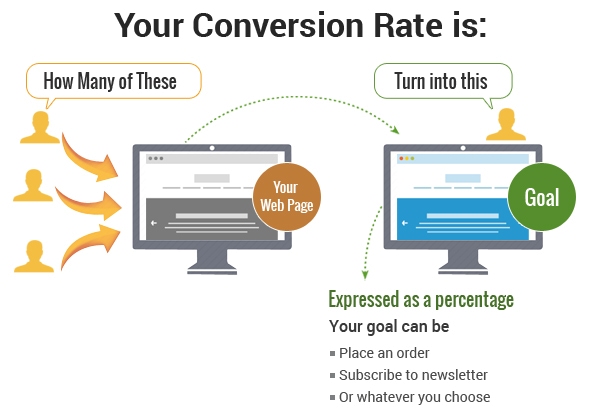Conversion
When designing a website to generate conversion, it is a common error to assume the needs and behaviour of web users. But, what happens when users collectively violate planned behaviour by doing things completely differently than it was intended?
“Legislation” and principles have been created for user interface design to help prevent major stumbling blocks on the website and thereby improve conversion.
 Usability principles in the user interface
Usability principles in the user interface
We are constantly facing websites that have these usability laws more or less.
The size and location of the item will have a significant impact on the time when the target is “reached”. A destination can mean a button, contact, or even a click on the desired page. This effect is called Fitt’s Law .
As the number of selections increases, the more options are available, the more complex it becomes. William Edmund Hick and Ray Hyman set out a law based on the familiar abundance of alternatives. They managed to examine the relationship between the number of stimuli present and an individual’s reaction time to any given stimulus.
Obviously, the more stimuli to choose from, the longer it takes the user to make a decision on which one to interact with. Web users provided with multiple choices have to take time to interpret and decide, giving them work they don’t want.
The formula for Hick’s Law is defined as follows:
RT = a + b log2 (n)
“RT” means the reaction time, “(n)” is the number of stimuli present, and “a” and “b” are arbitrary measurable constants based on the task that is to be carried out and the conditions under which it will be carried out. “A” could be finding the right present online for your mother-in-law; “B” could be an onscreen chat with your mother-in-law in which she reminds you it’s her birthday tomorrow.

The general user interface element is the call-to-action (CTA) button. For example, the Simplified ‘Frontpage Phone Number button’ on the ‘Towing Centre’ is clearly the most important element on the page that the user’s attention is required to take.
Fitts and Hick’s laws can be matched to call-to-action by directing the user towards conversion. Conversion Optimisation tests can find the best call-to-action ingredients: Which colour is most appealing, which text delivers to the user, or whether it is better to place the button on the right or left, or even in the middle as in the case above.
Simple usability for Websites that generate conversion
Simple usability is also created by getting used to certain things. In practice, this means that, over time, users have learned to use the most popular websites, and wish or expect consistency from other sites. Jakob’s Law is one of the most essential principles of usability. When we are accustomed to certain things acting and behaving in a certain way, it is difficult to present a new way of replacing the old with the will of the subconscious.
Online shopping has the same pattern for a long time: the shopping cart and login information are located at the top right, and the same categories of women, men, kids, etc. can be found in the store’s navigation.
Innovative and peculiar ideas are a good way to act and important features of design, but you should not reinvent everything. Confused users will leave the site with frustration if they don’t know how to use the site. Fighting subconsciously in the name of artistic freedoms is usually a bad idea!
Curse of the presumption
A great pitfall in user interface design is to assume on behalf of the user what they want from the website and how to achieve this. It is difficult to objectively evaluate a website that is constantly being dealt with. In this case, you should cut the razor blade into the stack and choose the most realistic and proven option.
Occam’s Razor is the principle of usability, according to which hypotheses are chosen with the least assumptions. On the way to the conversion principle, “Well, that’s how it all works,” you get a lot of bends, and quite right. We cannot define perfection, but we can define the requirements of simplicity.
Research for Conversion
By doing quantitative and qualitative research, you can find the weaknesses found in the user path – or confirm the choices. When we create hypotheses with certain assumptions, it is also important to confirm the outcome. “The user finds a link to a contact page from the drop-down menu” and “The user finds a link to a contact page at the bottom of the page” has two different hypotheses that can be tested and tested well. By testing, we are able to make factual decisions and make changes to the interface without any assumptions.
Neuropsychology is also essential for the pursuit of completeness. It has been studied that on average we are able to deal with seven (+/- 2) things in our work memory. Work Memory is a short-term active memory that captures all of what we have just experienced. This is also reflected in practice in what we react to and can react at the same time.
Too much is not worthwhile!
The usual website has abundance of content as highly recommended for SEO purposes, and it may be difficult to cut out the highlighted elements. However, offering abundance is not worthwhile sometimes, because the brain simply does not want to deal with too many options.
What’s important is that everything you need to find on the site is available, but in providing them to a user who doesn’t feel the site perfectly, you should be careful, as new studies have already indicated that five things would be closer to the magic number.
Google may already search for a more simplified webpage. Conversion Optimisation starts with optimising for web pages.
For example, e-commerce can hardly be created with just as simple starting points as Google can do. In this case, research and testing is done to ensure that the page is able to provide everything essential, and that the user path supports conversion in a good way.
Other principles of usability include, for example
- Von Restorff Effect
- Pareto Principle
- Parkinson’s Law
- Serial Position Effect
- Tesler’s Law
- Zeigarnik Effect
In the field of psychology, the most prominent representatives of the Gestalt School were Max Wertheimer, Kurt Koffka and Wolfgang Köhler.
The principles of the Gestalt, or figurines, are concerned with how our brains recognise the whole. Whether it was grouping, sketching an unfinished pattern, or a different pattern of small patterns.
Gestalt can be utilised in user interface design as an excellent emphasis on attention, or merely as a function of the subconscious.
Law of Good Shape
Gestalt of the basic principle of even the character itself describes the Law of good shape Law (Law of Prägnanz) or law of simplicity, refer to the human effort to understand the patterns as regular as possible. We are able to automatically identify a dog from the above image, even if it consists of points of different sizes.
Some of the law is self-evident, with less attention being paid to it. For example, the similarity law ( law of similarity ) serves as the cornerstone of the interpretation site, where the shapes, sizes or colours of similar patterns seen as belonging together. A similar law is again based on the layout of patterns and their grouping.
Law of Proximity
Its proximity to the law ( Law of proximity ) are perceptually the most obvious, but the webpage designing a small space merge practicality search a very important piece of legislation.
Two opposites can create the same results
The mass of shapes can be difficult to identify with each other. At its simplest, at other times, loose characters can be bundled together, even by dragging a line between them. Thus these characters may be interpreted in the same group connectedness Law ( Law of uniform connectedness ), although these would not be any other connecting element.
The lines of Don Rosan Ankan’s family tree, as usually in the family tree, are combined with patterns, in this case with tree branches. We see straight away the lines that are related to each other.
Law of Closure
On the contrary, there is no need to combine patterns to understand the end result. Sulkeutuvuuden Law ( Law of closure ) to fill the gaps into a single entity.
Few attention is drawn to the inadequacy of the classic WWF Panda, namely the black and white creature is not drawn. However, few have difficulty distinguishing a clear animal from this picture.
Other common Gestalt character laws include:
- Law of Simplicity
- Law of Symmetry
- Law of Continuity
- Law of Common Fate
- Law of Figure Ground
As it has already become clear at this stage, many principles are purely simple things that happen automatically, which take place subconsciously or consciously. Codes and principles can be called crosses under the names of others, and more ways can be cultivated at the same target type.
Gestalt’s laws are particularly related to human subconsciousness and psychology, by virtue of their ability to perceive and behave. Usability laws are more diverse, more directly related to user interface design, which need to be more consciously focused on.
Each principle or law emphasises each other, and the best user interface is utilised to the fullest extent possible.
There are no fully prepared solutions. Conversion Optimisation can affect the development of the user interface by the purpose of the page.
The brand of the pages should fit aside, and by blindly observing the principles of usability, you should definitely stay with the brand.




